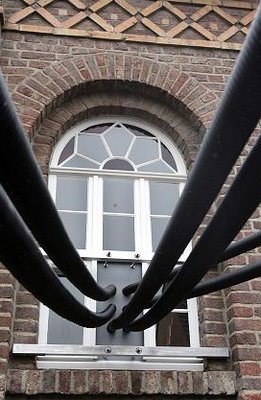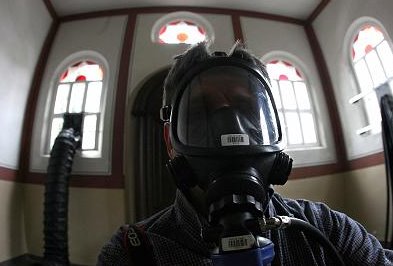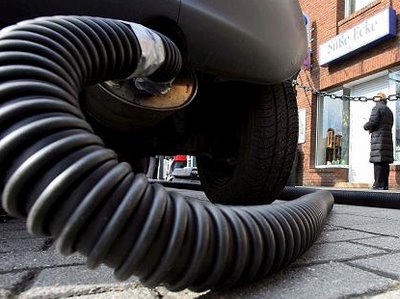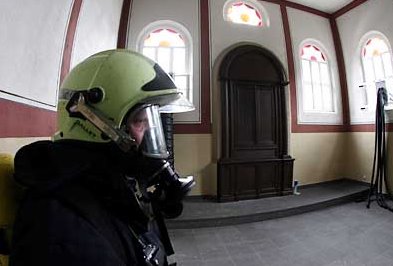
How could I have missed this!
Santiago Sierra is back. And, as usual, he's creating a stir. If it seemed to you he's been controversial enough, paying people to be tattooed or to carry stone squares around or to stay walled in during an exhibition, well, this time he seems to have outdone himself.
His project, called 245 Cubic Meters, was
to give people a sense of the Holocaust by pumping lethal car exhaust fumes into a former synagogue and letting visitors enter one by one with a breathing apparatus.I suppose everything worked out as planned: huge outrage, criticism, and a public debate about art, it's possible role in society and the way it can, should or does influence us.
The exhibition was suspended.
Here is my take on it.
1. I don't agree with the critics that claim Sierra's work is exactly what it claims to fight, i.e., "the trivialization of the Holocaust", as the artist put it. I don't think something becomes trivial just because you make a direct reference to it. Obviously, this isn't Disneyland, and nobody going in there must have made it light-heartedly. This is a very serious, heavy matter. When death is near, it is really too simple to discard it as "trivial".
 2. Taking place in Germany, the work can be seen as a cleansing ritual, more than a gesture of rememberance. Many Germans I know never dared to ask their fathers or granfathers what they did during the war (Hans in his note to my last post notes the ever-present figure of the goo-bad uncle).
2. Taking place in Germany, the work can be seen as a cleansing ritual, more than a gesture of rememberance. Many Germans I know never dared to ask their fathers or granfathers what they did during the war (Hans in his note to my last post notes the ever-present figure of the goo-bad uncle).3. Part of the cleansing is certainly the aethetic aspect of the work. Walking in an abandoned synagogue is a strong emotion. Walking with a firefighter-guide makes it even more surreal.
4. The firefighter is a very strong element. It was misinterpreted by several commentators as the proof of how ridiculous an attempt at restaging the drama can be. Well, I think it rather shows that this is not a restaging. This is a work of art, and is to be treated as such. It tells a story which goes beyond itself. It is not about reliving the moment. It is, maybe, about the possibility of reliving the moment. About the power of a place. Authenticity - yes. But authenticity of a place, of a history, of an event. Authenticity of a gas and of our reaction to it. Of the precautions we take. Today.

5. If Sierra was actually after the creepy feeling that all this was real, if he wanted to "remember", he could have simply made a trip to Auschwitz. It is a horrible, horrible place. I'm still not sure if I think it is a good thing for it to exist. Its struggle for memory gets scarily close to a fascination with death, the same one that makes us look at an accident or listen to a horrible story. Yes, it makes us remember. But I'm not sure if the cost is not, well, some sort of a pornography, if you may, an indecent exposure of something that really should have been put to rest. Nonetheless, it exists - it's there to see for anyone unsure if his memory is correct, unsure if he has enough disgust for what people can do to other people. I don't think we need Santiago Sierra to remind us of that.
6. The difference is that Sierra made his piece in a gallery space. In a synagogue. In Germany. I am really tired of having Poland associated with the Holocaust (I think I mentioned it some while ago). This work puts the finger to the wound. Right where it (still!) hurts.
7. How pretentious to seek to evoke their horror and fear of death in such a cheap way! In a cynical game which yields no insight whatsoever. - says a newspaper.
For some time, Santiago Sierra has been asking one question: "What if it were you?". His works are exercices in empathy. They are often cruel exercices. In this sense, yes, they get cynical.
This reminds me of the famous Stanley Milgram, a scientist often accused of cynicism, who discovered that most people can be unhumanly cruel by creating simple conditions (orders coming from an authority) that made them do what they thought to be acts of great cruelty. Milgram was accused of turning people into murderers, as if they were toys to play with. Sierra is accused of "hurting the dignity of the victims", as if they were toys to play with. I really don't see how the dignity of the victims is being hurt. And, contrary to some of his other works, here Sierra doesn't actually use anyone, he doesn't turn people into something just (?) for art's sake.
8. What he does play with is memory. And guilt. The synagogue is the sign, it is what made the difference when the selection was made during the war, it was what identified the victims and what differenciated them from the others (the killers, but also the by-standers). Here, the visitor becomes at once the victim, the perpetrator and the by-stander, the observer. Being the art spectator he is, he cannot help but have a distance. At the same time, he goes inside, he participates. He repeats history. As a victim, or as a re-creator?
9. To me, this last question is going too far. And not because it crosses some line of decency. Because from what I can imagine and see on the pictures (once again: what can I imagine and see on the picture? how far can imagination get me?), the conceptuality of the work is simply unbearable. Bluntly speaking: it seems boring. It is the second work by Sierra that I find interesting as a concept, but have difficulty finding strong as an actual work (The first one was 300 tons). I really don't feel like walking through an empty synagogue with a fireman just so Santiago Sierra can make his point. And having a gas mask on would hardly change my stance.
But honestly, I think I still haven't figured it all out quite yet.

Technorati:

6 comments:
He should have sent the visitors naked inside, without any masks and protections, but with harmless gas. Because the uniform of the visitors gives it something science fiction, and less murder.
Of course. But to me that is a very important part of the work - that one (as I imagine) doesn't feel the same authenticity as in a reproduction. Rather, you feel estranged, you feel, exactly as you put it, as if it were science fiction. Which shows us our own distance towards historical events- we are always strangers there, no use in trying to reenact things "just as they were".
So, we are at once part of this crazy "experiment", part of the craz history, and completely distant, aliens, in several meanings of the word. Alienated, foreign, out-of-this-world.
The twist you would have him made, naked with harmless gas, could of course be another version - although I doubt there would be lines piling up for that one - strange, isn't it? Is it because our culture (at least the "consumer's culture", possibly culture in a broader sense) treats death (and murder) as much more trivial than nakedness?
The fascinating thing with art is, that with a small variation, a small formal move in this or that direction, the piece can get an entire new dimension.
Like when one brushstroke may bring another different f.e. contradicting level to a almost finished painting.
But I think anyway, that his piece must fail to sense people a glimpse of the holocaust, because even to give a glimpse, thats impossible, if this was intended by the artist.
By the way, in your point 9, I think one big part of the tragedy was that just not the the synagoge played the most important role (with the relativ highly assimilated Germans with jewish roots), if they selected you or not, but rather the jewish ancestry, even if you haven't been much religous, but had jewish blood through your grandparents.
I think the simple facts, wether in a book or in a museum or in Auschwitz give much more und pure horror and glimpses than any piece of related art, because thats most of the time becoming a sort of circus or spectacle.
I have this feeling too with recent paintings by Joy Garnett, where I do not know what to think and how to handle the colorful bright paintings of burning (lynched) people. Link:
http://tinyurl.com/j9vvq
hans, discussing things with you is a pleasure. i feel like on a seminar where i need to stay focused and not say anything off the top of my head (which i do anyway), and where every meeting brings a new level.
now for your comments:
- every minimal difference can change everything? yes. and that's why i've always appreciated s.sierra's work. he has great formal discipline, never leaves a loose bolt.
- to be quite frank, i don't think the idea here is to "give a glimpse of the holocaust". the play here is much more subtle, i think. it might be introducing you into a specific world, making you look for the holocaust maybe...
about the synagogue... yes, you may well have a point here. in this sense, it had little to do with religious intolerance defined as hatred for a belief, and everything to do with racial intolerance, as in - hating someone for his origins. i wonder, though, if the catholic-haters of today (for instance) would hate me, an atheist but of a clearly catholic descendence? somehow, i feel they would, because what they reject is a system of values that is culture-based, and that culture has its root deep in religion. so in a sense, there is no escaping the synagogue. althoughyour point certainly makes this aspect a more complex one.
- circus, spectacle... yes, possibly. notice, though, that this is something we can object to in any form of art. and we can very well argue that what some call "circus" is basically the exposition of the issue, its bringing (re-bringing) to life. it is making it real for those who come later. that's why we need new museums, also to remember the holocaust. the thing itself becomes dusty, distant, and simply passes away. trying to keep it alive by just cleaning the dust is useless. that's why new books appear, that's why new museums appear, and yes, that's why new, controversial art works appear as well. as our vision changes, so does history. and we better keep up with it, or else it will become as distant and impersonal as the number 1939 can.
- i didn't know joy garnett. but what about botero's latest work? shouldn't he be criticized for the same reasons then?
I wonder if you read comments on old posts? Sierra's work is for me not only about history. The addition of cars gives it a currency. It has, after reading about it in your blog inspired another work. A piece that caused no reaction whatsoever because it took place in the chambers we call clean air. http://cuzner.wordpress.com/2007/03/17/police-caught-up/
Great blog. Art blogs are all about selection. Your selection is often on, if you ask me.
Thank you, Lars, for the nice words - and the link to the installation! It's true, the car element can be considered as crucial. I'm glad your installation had such a strong reaction. Makes it much more powerful, although costly as well...
Post a Comment